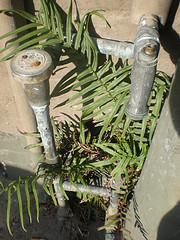 Little about the properties of tissue: – Chenille (translated from fr. "Caterpillar") – such an unusual name is one of the representatives jacquard material made by weaving colored threads with varying pitch and with a high density of filaments per unit area. Chenille – the warmest upholstery fabrics, so they won their popularity. The fabric is made by the technology developed in 18 century: beams pile, nachesannye on a special machine, twists of the fiber fabric basis. Shenillovye threads weave a simple form and fluffy threads, it does not stretch well into the overall structure of the tissue. Dignity of chenille that is very thick and durable fabric that has high wear resistance through the use of synthetic fibers. Its easy to clean and difficult stretch.
Little about the properties of tissue: – Chenille (translated from fr. "Caterpillar") – such an unusual name is one of the representatives jacquard material made by weaving colored threads with varying pitch and with a high density of filaments per unit area. Chenille – the warmest upholstery fabrics, so they won their popularity. The fabric is made by the technology developed in 18 century: beams pile, nachesannye on a special machine, twists of the fiber fabric basis. Shenillovye threads weave a simple form and fluffy threads, it does not stretch well into the overall structure of the tissue. Dignity of chenille that is very thick and durable fabric that has high wear resistance through the use of synthetic fibers. Its easy to clean and difficult stretch.
– Velour – the name derives from the Latin vellosus – hairy. Velours – knitted pile upholstery fabrics, for use in the wrapping of upholstered furniture complex shapes. This fabric with a split pile, obtained by intertwining the five strands. Four wire pairs form an upper and a lower base, and a fifth (usually velvet) is a nap. Then the fabric is cut between the two bases, separating them from each other. Thus, from the machine out two rolls of tissue.
Pile yarn determines the appearance, consumer characteristics and quality of fabric. On the structure of these tissues with stable knit weave. The main drawback Velour is a low (compared with other tissues), resistance to abrasion. – Flock – replacement velvet upholstery fabric with a basis of polyester and cotton (usually 35% – cotton, 65% – synthetic), which electrostatically applied to the pile. This gives a velvety flock surface. Flock meets the basic requirements that apply to upholstery fabrics. Floquet withstand any load, equipped with a dirt-and water-repellent impregnation. Not burns, washed neutral means. Has increased resistance to the claws of animals. – Tapestry – the history of manufacturing products from the tapestry has its roots in antiquity. It is produced as early as Ancient Egypt. Some methods of making tapestries still used, but its name is obliged to manufacture the fabric of French tapestry of the family. Basic method of making a tapestry is the alternation yarns of different colors, to send a gradual change in tone or muscle definition. 100% cotton. Tapestry is one of those natural, natural upholstery fabric, which always cause the buyer sustained interest. – Jacquard – Common name – artificial silk. The most ancient fabrics with patterns were Chinese fabrics from natural silk. More than three millennia ago in China already existed loom. The invention at the turn of 18-19 centuries Joseph Marie Jacquard machines for separate management warp heralded a new era in the development of Weaving. Several dozen brushes, running in different directions and at different angles, creating a detailed selected image. The fabric is dense, tough enough. Knotted loops, when tightening is not dissolved. – Nubuck – imitation leather, much cheaper than natural. Convincing imitation of a great consumer properties. – Skin – natural product. Leather – timeless material that over time it becomes just perfect. A variety of labels, often occurring on the skin is not a defect (though many think so). They arise as a result of a life lived animal, and give your furniture unique. The above Upholstery are by far the most common, but fierce competition among manufacturers encourage the emergence of new and new upholstery. Finding your way in this abundance you are always happy to help sales consultants chain of salons Quarter Divanov. light your purchase! Text: Quarter Sofas
Recent Comments